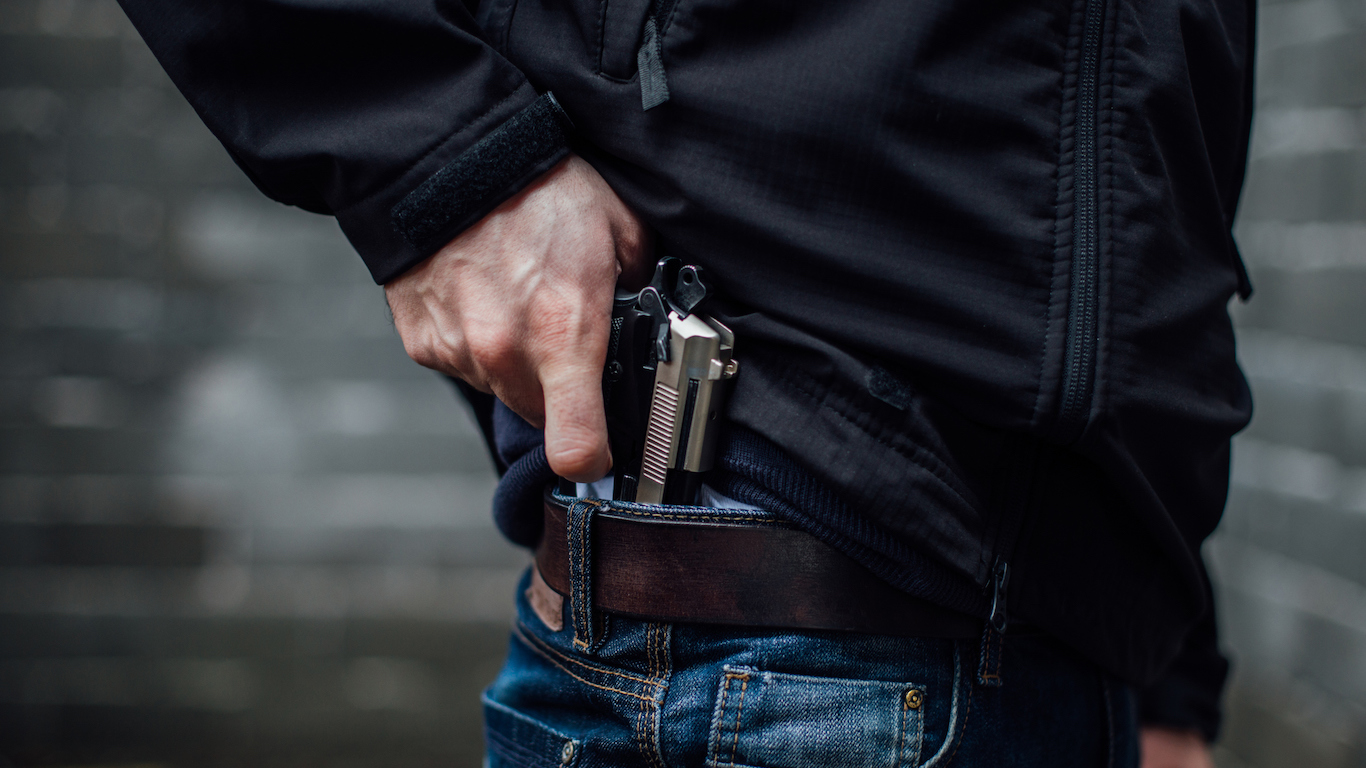
Warfare is the most harrowing example of violence. While the United States is actively engaged in military campaigns abroad, war, in the traditional sense, has not been fought on our soil in over 150 years. Still, violence manifests itself in this country in other ways.
The most common form of violence in the United States today is violent crime — a broad classification comprising four types of offenses: aggravated assault, robbery, rape, and homicide. Nationwide, there were 382.9 reported violent crimes for every 100,000 people in 2017, according to the FBI.
Another, perhaps less obvious, type of violence common in the United States are lawful punishments, specifically arrest and detention. There are currently 440 state and federal prisoners in the United States for every 100,000 people.
Additionally, in a perfectly peaceful society, there would be no need for small arms, the type typically used for self defense. Because accurate handgun ownership data is unavailable nationwide, suicide by firearm is commonly used as a proxy.
Rates of violent crime, incarceration, and suicide carried out with a firearm are not uniform across the country, and some states are far more violent places than others. 24/7 Wall St. created an index of these measures to identify the most peaceful and most violent states.
Generally, violence tends to be less common in areas with more economic opportunity. Many of the most violent states also have some of the highest unemployment rates in the country. Meanwhile, the most peaceful states tend to have strong economies and low unemployment. These are the states with the best and worst economies.
Across the country, in peaceful and more violent states alike, violent crimes tend to be concentrated in metropolitan areas. In many states, a single high-crime city can contribute considerably to overall higher levels of violence — these are the most dangerous cities in each state.
Click here to see America’s most violent and peaceful states
Click here to read our methodology

50. Rhode Island
> Violent crime rate: 232.2 per 100,000 residents (9th lowest)
> Murder rate: 1.9 per 100,000 residents (5th lowest)
> Incarceration rate: 170 per 100,000 residents (3rd lowest)
> 2018 unemployment: 4.1% (15th highest)
All six states in the New England region rank among the 10 most peaceful states, and of the six, Rhode Island ranks as the most peaceful — in the region and the country. Part of the explanation for the state’s rank is its low incarceration rate. There are just 170 inmates in state of federal prisons in the state for every 100,000 Rhode Island residents.
Violent crimes — a category comprising robbery, rape, aggravated assault, and murder — are also relatively uncommon in Rhode Island. There were just 232.2 violent crimes for every 100,000 people in the state in 2017, well below the 382.9 per 100,000 national violent crime rate, third lowest among states.
See all stories featuring: Rhode Island
[in-text-ad]

49. Hawaii
> Violent crime rate: 250.6 per 100,000 residents (13th lowest)
> Murder rate: 2.7 per 100,000 residents (13th lowest)
> Incarceration rate: 240 per 100,000 residents (10th lowest)
> 2018 unemployment: 2.4% (the lowest)
Hawaii has the lowest rate of gun violence in the United States. Over the last five years, there were an average of three deaths by firearm discharge a year for every 100,000 people in the state, a fraction of the national average of 10.9 deaths per 100,000. Overall, violent crimes are relatively rare in Hawaii, as the state’s violent crime rate of 250.6 per 100,000 is well below the national rate of 382.9 per 100,000.
States with lower than typical incidence of violence also tend to have relatively strong economies, and Hawaii is no exception. Just 2.4% of the state’s labor force was unemployed in 2018, well below the 3.9% U.S. unemployment rate.
See all stories featuring: Hawaii

48. Massachusetts
> Violent crime rate: 358.0 per 100,000 residents (25th highest)
> Murder rate: 2.5 per 100,000 residents (11th lowest)
> Incarceration rate: 120 per 100,000 residents (the lowest)
> 2018 unemployment: 3.3% (15th lowest)
Massachusetts has some of the strictest gun laws in the country, and the tight restrictions appear to be having a meaningful effect on gun violence. There were 3.2 deaths by firearm discharge in Massachusetts for every 100,000 over the last five years, well below the national firearm death rate of 10.9 per 100,000. The state also has the lowest suicide-by-firearm rate — which is part of the overall firearm death rate — of any state.
Massachusetts also locks up a smaller share of its residents than any other state, it has an incarceration rate of just 120 sentenced prisoners under state jurisdiction per 100,000 residents.
See all stories featuring: Massachusetts

47. New Jersey
> Violent crime rate: 228.8 per 100,000 residents (8th lowest)
> Murder rate: 3.6 per 100,000 residents (20th lowest)
> Incarceration rate: 217 per 100,000 residents (8th lowest)
> 2018 unemployment: 4.1% (15th highest)
Violence is relatively uncommon in New Jersey. The violent crime rate of 228.9 incidents per 100,000 people in the state is well below the national rate of 382.9 per 100,000. Rape, one of the four types of violent crimes, is particularly uncommonly reported. There were 16.7 reported rapes for every 100,000 people in New Jersey in 2017, the lowest of any state.
Violence tends to be less common in high-income areas with well educated populations. In New Jersey, the typical household earns $80,088 a year, about $20,000 more than the typical American household. Additionally, 39.7% of adults in the state have a bachelor’s degree or higher, well above the 32.0% national bachelor’s degree attainment rate.
See all stories featuring: New Jersey
[in-text-ad-2]

46. Connecticut
> Violent crime rate: 228.0 per 100,000 residents (7th lowest)
> Murder rate: 2.8 per 100,000 residents (15th lowest)
> Incarceration rate: 268 per 100,000 residents (14th lowest)
> 2018 unemployment: 4.1% (15th highest)
Connecticut is fifth least violent state in the country and the third least violent in the New England region. There were 228.0 violent crimes for every 100,000 people in the state compared to 382.9 per 100,000 nationwide. As is the case nationwide, the violence is more common in Connecticut’s cities. The vast majority of violent crimes in Connecticut — 94.6% — were committed in metropolitan areas. Slightly over 80% of the state’s population lives in metro areas.
Although the state was home to one of the deadliest mass shootings in U.S. history, Connecticut has a relatively low rate of gun violence. Over the last five years, there were 4.8 firearm fatalities annually for every 100,000 people, less than half the national firearm death rate of 10.9 per 100,000.
See all stories featuring: Connecticut

45. New Hampshire
> Violent crime rate: 198.7 per 100,000 residents (3rd lowest)
> Murder rate: 1.0 per 100,000 residents (the lowest)
> Incarceration rate: 204 per 100,000 residents (6th lowest)
> 2018 unemployment: 2.5% (3rd lowest)
New Hampshire is one of only three states with fewer than 200 violent crimes per 100,000 residents. Non-violent crimes are also uncommon in New Hampshire. There were 1,381.8 property crimes — a broad category that includes burglary, larceny, and motor vehicle theft — for every 100,000 people in the state in 2017, the lowest property crime rate in the country.
Higher-income areas typically report lower levels of violence. In New Hampshire, the typical household earns $73,381 annually, enough to rank among the richest states in America.
See all stories featuring: New Hampshire
[in-text-ad]

44. Maine
> Violent crime rate: 121.0 per 100,000 residents (the lowest)
> Murder rate: 1.7 per 100,000 residents (3rd lowest)
> Incarceration rate: 134 per 100,000 residents (2nd lowest)
> 2018 unemployment: 3.4% (20th lowest)
Maine’s violent crime rate of 121 incidents per 100,000 people is the lowest of any state. Aggravated assault, the most common type of violent crime nationwide is particularly rare in Maine. There were 65.3 aggravated assaults for every 100,000 people in the state in 2017, less than a third of the national aggravated assault rate of 249 per 100,000.
Maine is a largely rural state, and unlike the U.S. as a whole, violence is not concentrated in Maine’s cities. Just over a quarter of violent crimes reported in the state in 2017 were committed in a metro area. For reference, 59.4% of Maine’s population lives in a metropolitan area. Even in Maine’s most dangerous city, violent crime is less common than it is nationwide.
See all stories featuring: Maine

43. New York
> Violent crime rate: 356.7 per 100,000 residents (24th lowest)
> Murder rate: 2.8 per 100,000 residents (14th lowest)
> Incarceration rate: 249 per 100,000 residents (11th lowest)
> 2018 unemployment: 4.1% (15th highest)
New York’s violent crime rate of 356.7 incidents per 100,000 people is higher than the comparable rate in most of the more peaceful state. Still, it is considerably lower than the national violent crime rate of 382.9 incidents per 100,000 people.
New York’s rank as the seventh most peaceful state is largely attributable to the low rates of gun violence in the state. There were 2.1 suicides by firearm for every 100,000 people in the state over the last five years, less than a third of the comparable national rate of 6.6 per 100,000. None of the 10 U.S. cities with the most gun violence are in New York state.
See all stories featuring: New York

42. Minnesota
> Violent crime rate: 238.3 per 100,000 residents (11th lowest)
> Murder rate: 2.0 per 100,000 residents (6th lowest)
> Incarceration rate: 191 per 100,000 residents (5th lowest)
> 2018 unemployment: 2.9% (8th lowest)
Minnesota has one of the lowest murder rates of any state. There were 2.0 murders for every 100,000 states residents in 2017, less than half the national murder rate of 5.3 per 100,000. Minnesota also has the fifth lowest state incarceration rate, locking up about 191 people for every 100,000 state residents, or 10,700 people in total.
Minnesota is the only state in the Midwest to rank among the 10 most peaceful states. The majority of the most peaceful states are located in the Northeast.
See all stories featuring: Minnesota
[in-text-ad-2]

41. Vermont
> Violent crime rate: 165.8 per 100,000 residents (2nd lowest)
> Murder rate: 2.2 per 100,000 residents (8th lowest)
> Incarceration rate: 180 per 100,000 residents (4th lowest)
> 2018 unemployment: 2.7% (5th lowest)
There were 165.8 violent crimes for every 100,000 people in Vermont in 2017, the second lowest rate in the country, trailing only nearby Maine. Vermont also has the fourth lowest state incarceration rate in the country, locking up just 180 people for every 100,000 residents.
Although it has relatively loose firearm restrictions relative to most of the other 10 least violent states, gun violence is slightly less common in Vermont than it is nationwide. There were 10.3 firearm-involved fatalities for every 100,000 in Vermont over the last five years, compared to 10.9 per 100,000 nationwide.
See all stories featuring: Vermont

40. Utah
> Violent crime rate: 238.9 per 100,000 residents (12th lowest)
> Murder rate: 2.4 per 100,000 residents (9th lowest)
> Incarceration rate: 206 per 100,000 residents (7th lowest)
> 2018 unemployment: 3.1% (12th lowest)
Utah is the least violent state in the continentail Western United States. There were 238.9 violent crimes for every 100,000 people in the state in 2017, well below the violent crime rate of 382.9 per 100,000 nationwide. Utah’s incarceration rate of 206 per 100,000 is also among the lowest in the nation.
In other measures, Utah is lagging behind much of the country, however. Suicide by firearm is a considerable problem in the state. For every 100,0000 people in Utah, there were 11.0 suicides carried out with a firearm over the last five years, more than in all but six states and well above the national rate of 6.6 suicides by firearm per 100,000.
See all stories featuring: Utah
[in-text-ad]

39. Nebraska
> Violent crime rate: 305.9 per 100,000 residents (20th lowest)
> Murder rate: 2.2 per 100,000 residents (7th lowest)
> Incarceration rate: 273 per 100,000 residents (15th lowest)
> 2018 unemployment: 2.8% (7th lowest)
Nebraska ranks as the 12th most peaceful state and the second most peaceful state in the Midwest, trailing only Minnesota. The state’s violent crime rate of 305.9 per 100,000 is well below the national rate of 382.9 per 100,000. Gun violence specifically is relatively rare. There were 8.9 fatalities by firearm for every 100,000 people in the state over the last five years compared to 10.9 per 100,000 nationwide.
As is the case in other relatively peaceful states, economic conditions in Nebraska are favorable, particularly the state’s job market. Just 2.8% of Nebraska’s labor force was out of a job in 2018, one of the lowest unemployment rates in the country and well below the 3.9% national unemployment rate.
See all stories featuring: Nebraska

38. North Dakota
> Violent crime rate: 281.3 per 100,000 residents (14th lowest)
> Murder rate: 1.3 per 100,000 residents (2nd lowest)
> Incarceration rate: 226 per 100,000 residents (9th lowest)
> 2018 unemployment: 2.6% (4th lowest)
Only 13 states have a lower violent crime rate than North Dakota’s 281.3 reported incidents per 100,000 people. The state’s homicide rate is especially low. There were only 10 murders in the state in 2017, or 1.3 murders for every 100,000 residents in 2017 — the second lowest rate after New Hampshire and well below the national homicide rate of 5.3 per 100,000.
There is room for improvement in North Dakota, however. Deaths by firearm are more common in the state than across the country as a whole, largely due to suicides. There were 10.6 suicides carried out with a gun for every 100,000 people in North Dakota over the last five years, well above the national rate of 6.6 per 100,000.
See all stories featuring: North Dakota

37. Washington
> Violent crime rate: 304.5 per 100,000 residents (19th lowest)
> Murder rate: 3.1 per 100,000 residents (17th lowest)
> Incarceration rate: 262 per 100,000 residents (13th lowest)
> 2018 unemployment: 4.5% (9th highest)
Washington’s violent crime rate of 304.5 reported incidents per 100,000 people is well below the national violent crime rate of 382.9 per 100,000. Of the four types of violent crime — aggravated assault, robbery, rape, and murder — rape is the only one with a higher than average incidence rate in the state.
While violence is relatively uncommon in the state, non-violent crimes are far more common. There were 3,174 property crimes — a broad category that includes burglary, larceny, and motor vehicle theft — for every 100,000 people in the state in 2017, more than in all but four other states.
See all stories featuring: Washington
[in-text-ad-2]

36. Iowa
> Violent crime rate: 293.4 per 100,000 residents (17th lowest)
> Murder rate: 3.3 per 100,000 residents (19th lowest)
> Incarceration rate: 285 per 100,000 residents (16th lowest)
> 2018 unemployment: 2.5% (3rd lowest)
Violent crime is far less common in Iowa than it is nationwide. Across the state, there were 293.4 reported incidents for every 100,000 people — compared to 382.9 per 100,000 nationwide. Robbery in particular is far less common in Iowa than it is nationwide. Iowa’s robbery rate of 39.8 incidents per 100,000 people is less than half the comparable national rate of 98.1 per 100,000.
Not all corners of the state are safe, however. In Iowa’s most dangerous city, there were over 1,000 violent crimes reported for every 100,000 people.
See all stories featuring: Iowa

35. Oregon
> Violent crime rate: 281.8 per 100,000 residents (15th lowest)
> Murder rate: 2.5 per 100,000 residents (10th lowest)
> Incarceration rate: 364 per 100,000 residents (25th lowest)
> 2018 unemployment: 4.2% (13th highest)
Oregon ranks among the more peaceful states due largely to a lower than average violent crime rate. There were 281.8 reported incidents for every 100,000 people in the state, compared to 382.9 per 100,000 nationwide. As is the case nationwide, violence in Oregon is concentrated in cities. Only about 15% of violent crimes in the state are reported outside of metropolitan areas.
While violent crimes are relatively uncommon in the state, non-violent crimes are. There were 2,986 property crimes for every 100,000 people in Oregon in 2017, more than in all but six other states.
See all stories featuring: Oregon
[in-text-ad]

34. Idaho
> Violent crime rate: 226.4 per 100,000 residents (6th lowest)
> Murder rate: 1.9 per 100,000 residents (4th lowest)
> Incarceration rate: 447 per 100,000 residents (14th highest)
> 2018 unemployment: 2.8% (7th lowest)
Far safer than most other states, the murder rate in Idaho of 1.9 incidents per 100,000 people is among the lowest of any state. Rates of rape and aggravated assault are also below the national averages, and Idaho’s robbery rate of 11.4 incidents per 100,000 people is the lowest of any state and a fraction of the national rate of 98.1 per 100,000. While such acts of violence are relatively rare in Idaho, other forms of violence are not.
Idaho has some of the most relaxed gun laws in the country — and greater than average rates of gun violence. Due primarily to suicides carried out with a firearm, there were 14.4 deaths by firearm for every 100,000 state residents compared to 10.9 per 100,000 nationwide.
See all stories featuring: Idaho

33. Wisconsin
> Violent crime rate: 319.9 per 100,000 residents (22nd lowest)
> Murder rate: 3.2 per 100,000 residents (18th lowest)
> Incarceration rate: 391 per 100,000 residents (22nd highest)
> 2018 unemployment: 3.0% (11th lowest)
The incidence rate of every form of violent crime — rape, robbery, aggravated assault, and murder — is lower in Wisconsin that it is nationwide. Overall, there were 319.9 reported violent crimes in the state for every 100,000 people, below the 382.9 per 100,000 national violent crime rate.
Gun violence is relatively rare in Wisconsin. There were 9.9 deaths by firearm in the state for every 100,000 people over the last five years, compared to 10.9 per 100,000 nationwide. Not all parts of the state have low rates of gun violence, however. One Wisconsin city ranks among the 10 worst cities for gun violence nationwide.
See all stories featuring: Wisconsin
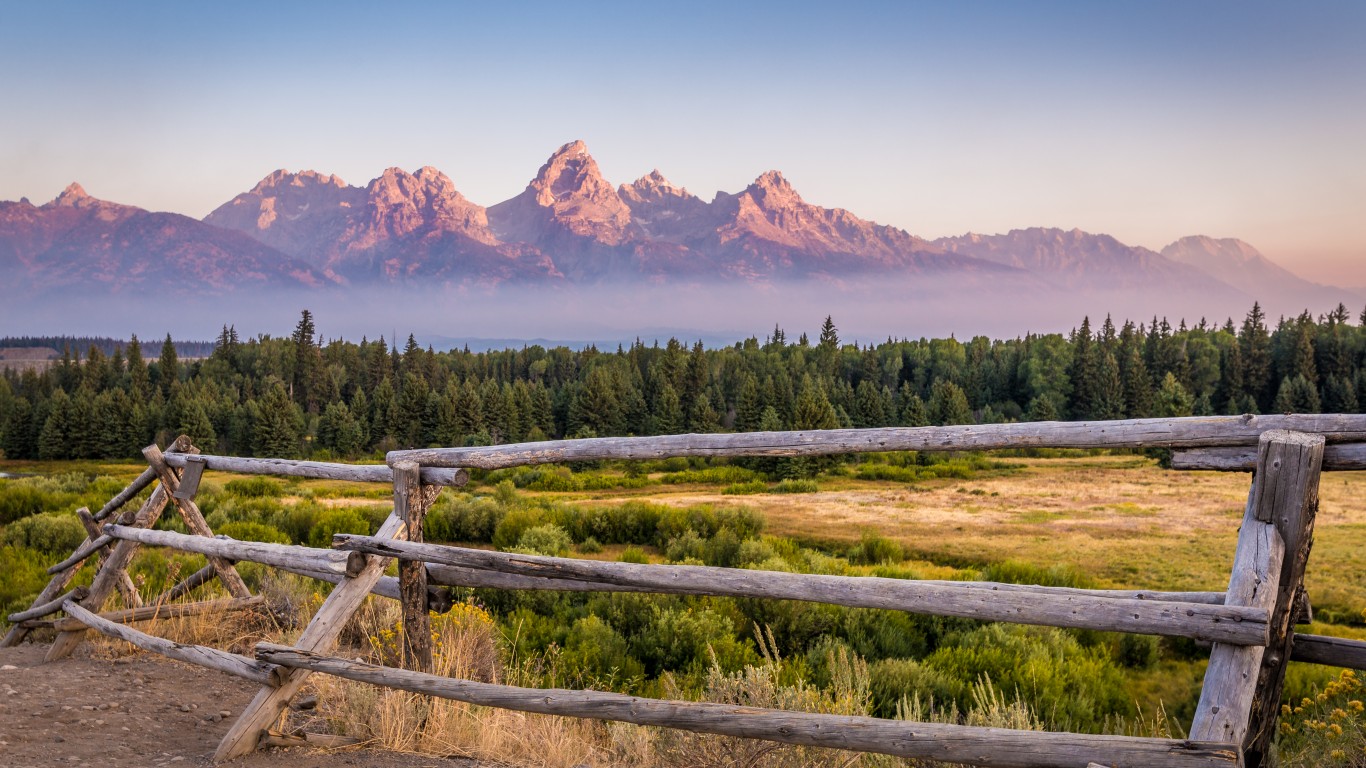
32. Wyoming
> Violent crime rate: 237.5 per 100,000 residents (10th lowest)
> Murder rate: 2.6 per 100,000 residents (12th lowest)
> Incarceration rate: 429 per 100,000 residents (17th highest)
> 2018 unemployment: 4.1% (15th highest)
There were 237.5 violent crimes for every 100,000 people in Wyoming in 2017, well below the national violent crime rate of 382.9 incidents per 100,000 people. While crimes like murder, robbery, and aggravated assault are less common in Wyoming than nationwide, other forms of violence are more common.
Suicide by firearm is a bigger problem in Wyoming than in nearly all other states. There were 448 firearms suicides over the last five years, or about 15 for every 100,000 people — the third highest rate of any state, trailing only Montana and Alaska.
See all stories featuring: Wyoming
[in-text-ad-2]

31. California
> Violent crime rate: 449.3 per 100,000 residents (15th highest)
> Murder rate: 4.6 per 100,000 residents (23rd lowest)
> Incarceration rate: 328 per 100,000 residents (19th lowest)
> 2018 unemployment: 4.2% (13th highest)
Violent crime is slightly more common in California than it is nationwide. There were 449.3 incidents of violent crime reported for every 100,000 people in 2017, compared to 382.9 per 100,000 nationwide. Additionally, two of the deadliest mass shootings in the United States in the last two decades were committed in California.
Despite higher rates of violence, California locks up a smaller share of its citizens than most other states. California’s incarceration rate of 328 per 100,000 residents is also lower than that of the majority of states.
See all stories featuring: California
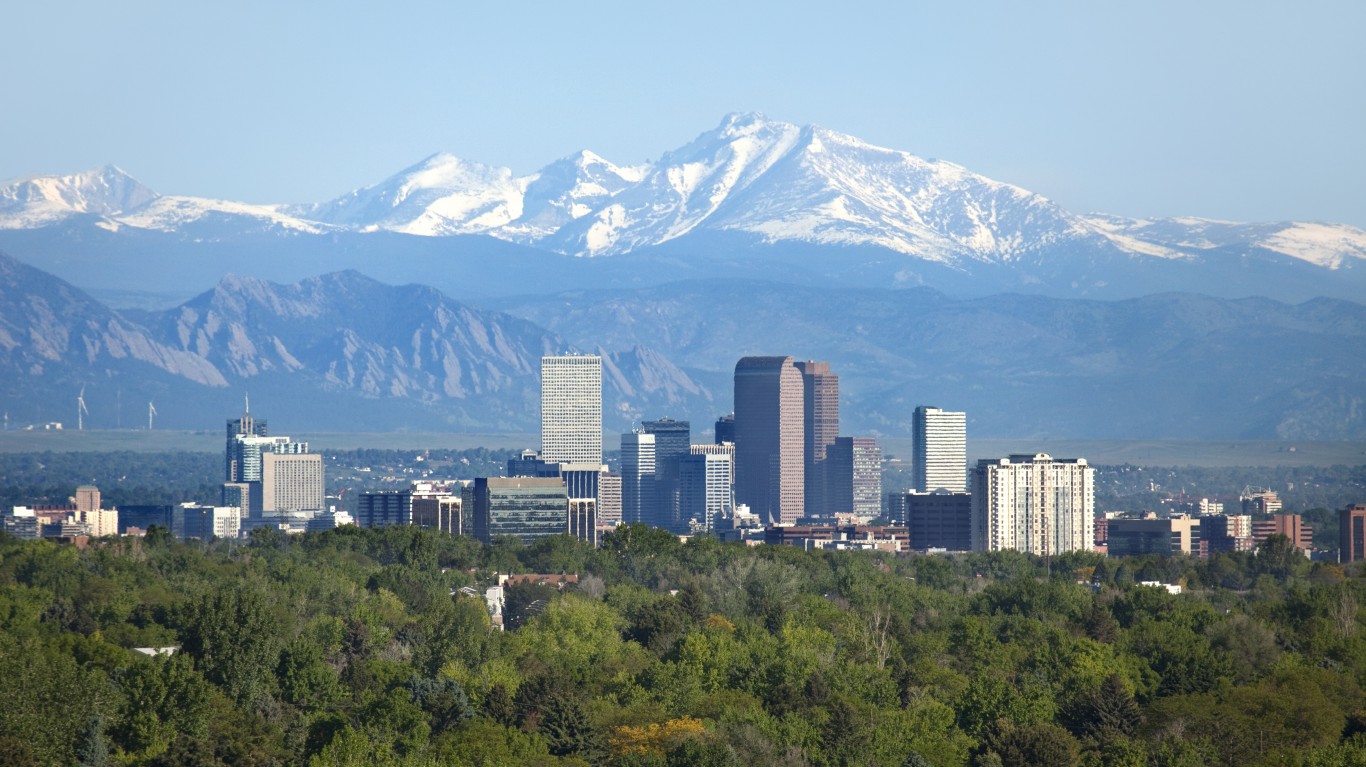
30. Colorado
> Violent crime rate: 368.1 per 100,000 residents (23rd highest)
> Murder rate: 3.9 per 100,000 residents (22nd lowest)
> Incarceration rate: 351 per 100,000 residents (24th lowest)
> 2018 unemployment: 3.3% (15th lowest)
Of the four categories of violent crime — rape, robbery, aggravated assault, and murder — rape is the only one with a higher incidence rate in Colorado than nationwide. There were 68.8 reported rapes for every 100,000 Colorado residents in 2017 compared to 41.7 per 100,000 nationwide. Overall, however, Colorado’s violent crime rate of 368.1 is slightly below the national violent crime rate of 382.9 per 100,000.
Like several other western states, Colorado has a higher rate of gun violence than is typical nationwide. Two of the 18 deadliest mass shootings in the last 20 years were carried out in Colorado.
See all stories featuring: Colorado
[in-text-ad]
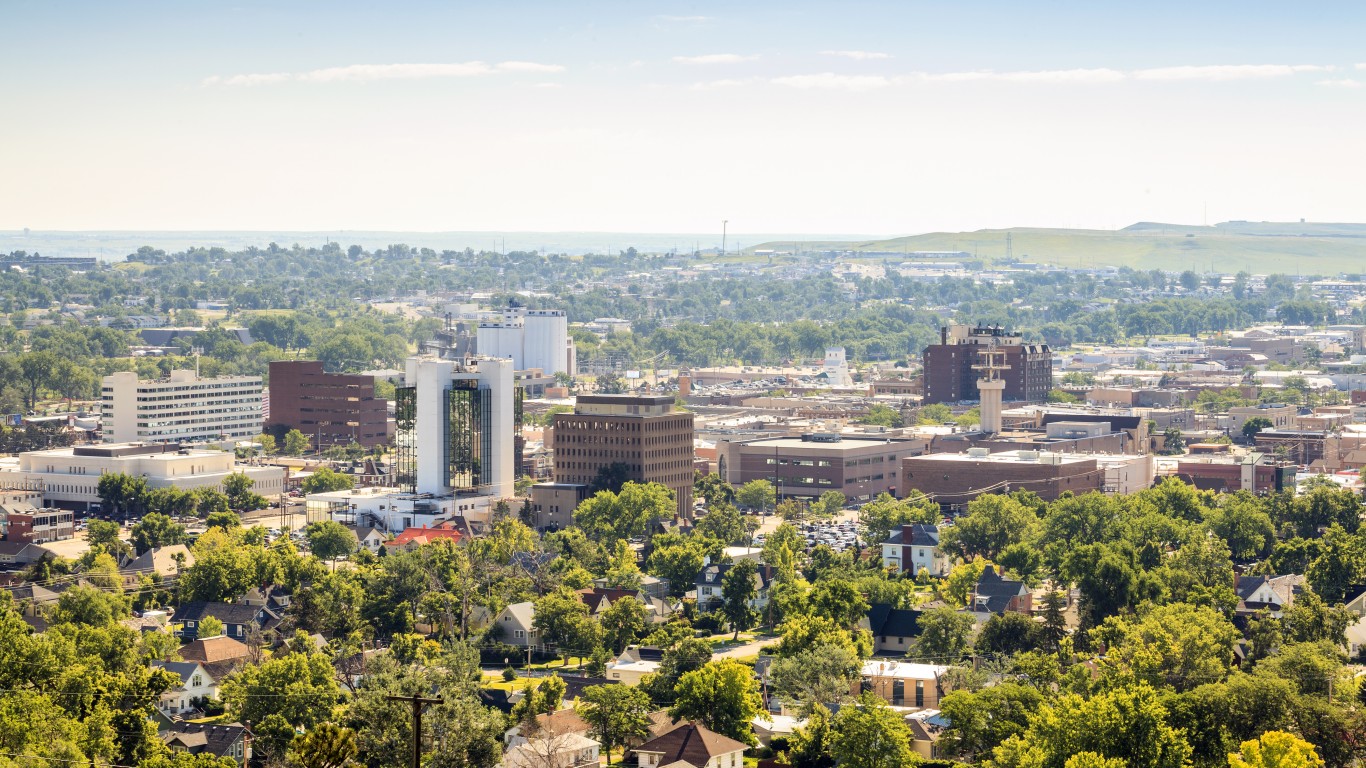
29. South Dakota
> Violent crime rate: 433.6 per 100,000 residents (18th highest)
> Murder rate: 2.9 per 100,000 residents (16th lowest)
> Incarceration rate: 453 per 100,000 residents (12th highest)
> 2018 unemployment: 3.0% (11th lowest)
South Dakota’s violent crime rate of 433.6 reported incidents per 100,000 people is well above the national violent crime rate of 382.9 per 100,000. Violent crime in the state is driven up by higher than average rates of rape and aggravated assault.
South Dakota’s incarceration rate of 453 prisoners for every 100,000 state residents falls roughly in the middle of the rank of state incarceration rates. Similarly, the rate of deaths by firearm in the state is closely aligned with the national rate of 10.9 deaths for every 100,000 people over the last five years.
See all stories featuring: South Dakota

28. Virginia
> Violent crime rate: 208.2 per 100,000 residents (4th lowest)
> Murder rate: 5.3 per 100,000 residents (24th highest)
> Incarceration rate: 437 per 100,000 residents (16th highest)
> 2018 unemployment: 3.0% (11th lowest)
Virginia’s violent crime rate of 208.2 reported incidents per 100,000 people is one of the lowest of any state and well below the national rate of 382.9 per 100,000. However, while violent crime in general is not especially common in the state, Virignia’s murder rate is slightly higher than average. There were 5.4 murders for every 100,000 people in the state in 2017 compared to 5.3 per 100,000 nationwide.
Virginia has relatively lax gun laws compared to many other states, but gun violence is not especially common in the state. There were 10.9 firearm deaths for every 100,000 people in the state in 2017, in line with the national firearm fatality rate.
See all stories featuring: Virginia

27. Pennsylvania
> Violent crime rate: 313.3 per 100,000 residents (21st lowest)
> Murder rate: 5.8 per 100,000 residents (19th highest)
> Incarceration rate: 375 per 100,000 residents (25th highest)
> 2018 unemployment: 4.3% (10th highest)
Pennsylvania’s violent crime rate of 313.3 incidents per 100,000 people is lower than in most states and well below the national violent crime rate of 382.9 per 100,000. While some forms of violence — such as several components of violent crime like rape, robbery, and aggravated assault — are relatively rare in the state, other forms of violence not considered in violent crime statistics, are more common than usual. For example, there were 14.1 suicides involving a firearm for every 100,000 state residents over the last five years, slightly higher than the comparable national rate of 13.2 per 100,000.
See all stories featuring: Pennsylvania
[in-text-ad-2]

26. Ohio
> Violent crime rate: 297.5 per 100,000 residents (18th lowest)
> Murder rate: 6.1 per 100,000 residents (15th highest)
> Incarceration rate: 441 per 100,000 residents (15th highest)
> 2018 unemployment: 4.6% (7th highest)
Aggravated assault is by far the most commonly reported violent crime in the United States, with 248.9 reported incidents per 100,000 people. In Ohio, the aggravated assault rate is far lower than average, with just 141.6 incidents per 100,000 people. Partially as a result, Ohio’s overall violent crime rate is far lower than the national rate.
While Ohio is generally safer than the U.S. as a whole, as evidenced by the lower violent crime rate, parts of the state are not safer. In Ohio’s most dangerous city, the violent crime rate is more than quadruple the national violent crime rate. Additionally, Ohio’s murder rate of 6.1 per 100,000 people is considerably higher than the national murder rate of 5.3 per 100,000.
See all stories featuring: Ohio

25. Montana
> Violent crime rate: 377.1 per 100,000 residents (22nd highest)
> Murder rate: 3.9 per 100,000 residents (21st lowest)
> Incarceration rate: 350 per 100,000 residents (23rd lowest)
> 2018 unemployment: 3.7% (24th lowest)
There were 377.1 violent crimes for every 100,000 people in Montana in 2017, slightly below the national rate of 382.9 per 100,000.
While violent crime overall is slightly less common in the state than it is nationwide, gun violence — suicide in particular — is far more common. Montana has some of the least restrictive gun laws in the country, and there were 15.7 suicides by firearm for every 100,000 people over the last five years, the second highest rate of any state and well more than double the 6.6 per 100,000 national rate. Montana’s overall suicide rate of 25.5 incidents per 100,000 people over the last five years is also the highest among states.
See all stories featuring: Montana
[in-text-ad]

24. Kansas
> Violent crime rate: 413.0 per 100,000 residents (19th highest)
> Murder rate: 5.5 per 100,000 residents (23rd highest)
> Incarceration rate: 332 per 100,000 residents (20th lowest)
> 2018 unemployment: 3.4% (20th lowest)
Kansas’s violent crime rate of 413 incidents per 100,000 people is one of the higher rates among states and is higher than the 382.9 per 100,000 national rate. Violence is disproportionately concentrated in urban areas within the state. Though only 68.1% of Kansas’s population lives within metro areas, over three-quarters of all violent crimes in the state are committed in metropolitan areas. In Kansas’s most dangerous city, there were more than 1,000 violent crimes for every 100,000 people in 2017.
See all stories featuring: Kansas

23. Florida
> Violent crime rate: 408.0 per 100,000 residents (20th highest)
> Murder rate: 5.0 per 100,000 residents (25th highest)
> Incarceration rate: 466 per 100,000 residents (11th highest)
> 2018 unemployment: 3.6% (22nd lowest)
Florida ranks as a slightly more violent state than average in several measures. For example, the state’s violent crime rate of 408 incidents per 100,000 people is slightly higher than the U.S. rate of 382.9 per 100,000. The state’s incarceration rate of 466 inmates per 100,000 people is 11th highest among states.
Firearm-related deaths, including murder and suicide, are also slightly more common in Florida than nationwide. Two of the 18 deadliest mass shootings in the last 20 years were carried out in Florida.
See all stories featuring: Florida
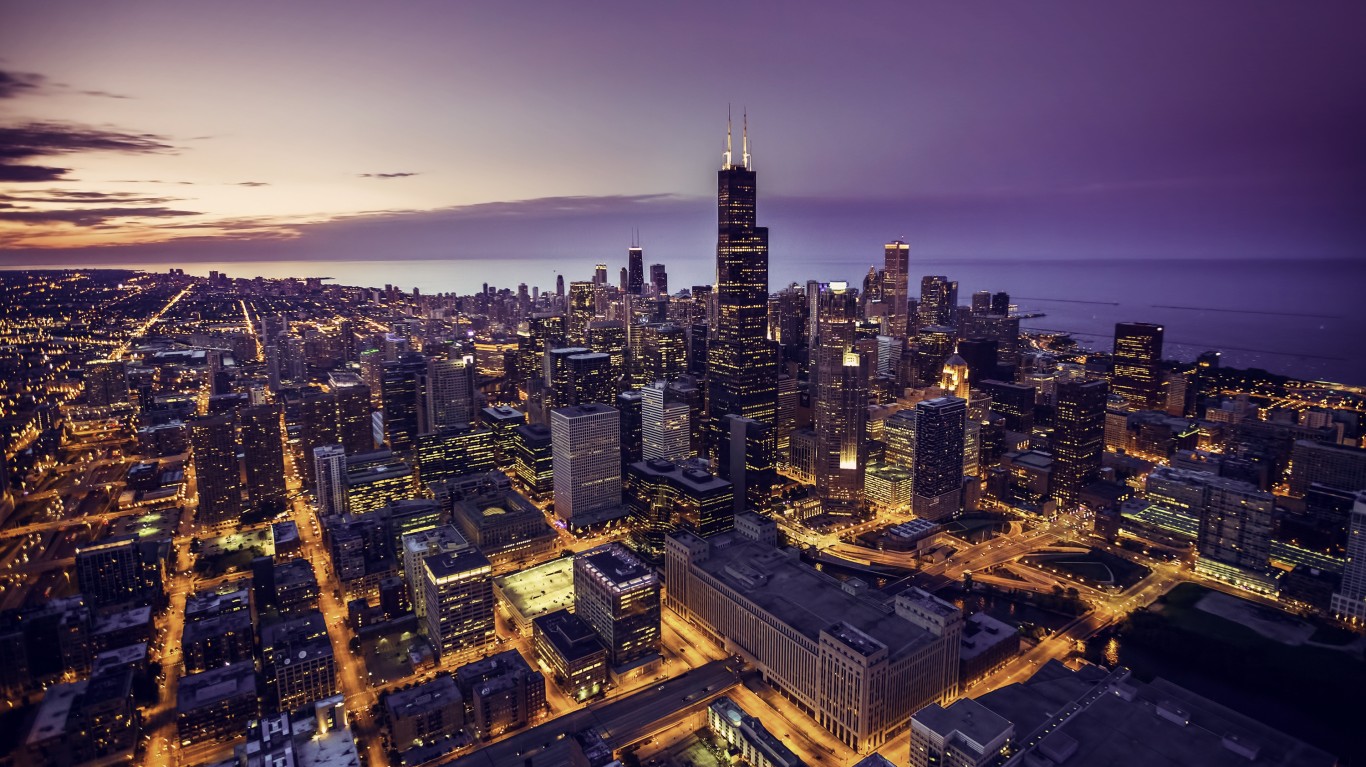
22. Illinois
> Violent crime rate: 438.8 per 100,000 residents (17th highest)
> Murder rate: 7.8 per 100,000 residents (10th highest)
> Incarceration rate: 324 per 100,000 residents (18th lowest)
> 2018 unemployment: 4.3% (10th highest)
Few U.S. cities are more notorious for violence — gun violence in particular — than Chigaco. Over 530 people were murdered in the city in 2018, and Chicago ranks among the 10 U.S. cities with the most gun violence. Partially as a result of Chicago’s high incidence of violence, over 96% of murders in Illinois were committed in metropolitan areas when only about 88.5% of the state population lives in metro areas. While gun violence may be heavily concentrated on Chicago’s city streets, it is not especially common across the state as a whole. There were 10.1 firearm-related deaths, including suicides, for every 100,000 people in Illinois in the last five years, slightly less than the national rate of 10.9 per 100,000.
See all stories featuring: Illinois
[in-text-ad-2]

21. Kentucky
> Violent crime rate: 225.8 per 100,000 residents (5th lowest)
> Murder rate: 5.9 per 100,000 residents (18th highest)
> Incarceration rate: 527 per 100,000 residents (8th highest)
> 2018 unemployment: 4.3% (10th highest)
Kentucky’s violent crime rate of 225.8 incidents per 100,000 people is lower than the national rate of 382.9 per 100,000. The state’s murder rate, however, is higher. There were 5.9 murders in Kentucky for every 100,000 people in 2017 compared to 5.3 per 100,000 nationwide. Kentucky also locks up more of its citizens than most states. Kentucky’s incarceration rate of 527 inmates for every 100,000 people is eighth highest among states.
See all stories featuring: Kentucky

20. North Carolina
> Violent crime rate: 363.7 per 100,000 residents (24th highest)
> Murder rate: 5.8 per 100,000 residents (20th highest)
> Incarceration rate: 341 per 100,000 residents (21st lowest)
> 2018 unemployment: 3.9% (21st highest)
North Carolina’s violent crime rate of 363.7 incidenter per 100,000 people is slightly below the national rate of 382.9 per 100,000. The only component of the overall violent crime rate that is higher than average in North Carolina is the murder rate. There were 5.8 murders for every 100,000 people in the state in 2017 compared to 5.3 per 100,000 nationwide.
Gun violence is also more common in North Carolina than it is nationwide. There were 12.6 deaths by firearm, including suicides, for every 100,000 North Carolina residents in the last five years compared to 10.9 per 100,000 nationwide.
See all stories featuring: North Carolina
[in-text-ad]

19. Delaware
> Violent crime rate: 453.4 per 100,000 residents (13th highest)
> Murder rate: 5.6 per 100,000 residents (22nd highest)
> Incarceration rate: 420 per 100,000 residents (19th highest)
> 2018 unemployment: 3.8% (25th lowest)
Only 12 states have a higher violent crime rate than Delaware’s rate of 453.4 reported incidents per 100,000 people. The state’s relatively high rate of violent crime is driven largely by higher than average rates of robbery and aggravated assault.
Despite the higher than average rates of violence, Delaware locks up a smaller than typical share of its citizens. The state’s incarceration rate of 420 per 100,000 people is 19th highest among states.
See all stories featuring: Delaware

18. West Virginia
> Violent crime rate: 350.7 per 100,000 residents (23rd lowest)
> Murder rate: 4.7 per 100,000 residents (24th lowest)
> Incarceration rate: 392 per 100,000 residents (21st highest)
> 2018 unemployment: 5.3% (2nd highest)
Gun violence is far more common in West Virginia than it is across the U.S. as a whole. Due primarily to a high rate of suicide by firearm, there were 15.3 gun deaths for every 100,000 people in West Virginia in over the last five years, well above the 10.9 per 100,000 national rate. The state’s violent crime rate of 350.7 incidents per 100,000 people, however, is slightly lower than the national rate of 382.9 per 100,000.
Homicide in West Virginia is disproportionately concentrated in cities. Though only about 62% of the state population lives within metro areas, 73% of murders in the state are committed in metropolitan areas.
See all stories featuring: West Virginia

17. Michigan
> Violent crime rate: 450.0 per 100,000 residents (14th highest)
> Murder rate: 5.7 per 100,000 residents (21st highest)
> Incarceration rate: 397 per 100,000 residents (20th highest)
> 2018 unemployment: 4.1% (15th highest)
Only 13 states have a higher violent crime rate than Michigan. There were 44,826 violent crimes reported in the state in 2017, or 450 for every 100,000 people.
Violent crime in Michigan — homicide in particular — is disproportionately concentrated in urban areas. Nearly 90% of all violent crimes and 93% of murders in the state are committed in metropolitan areas, even as metro areas are home to only about 82% of the total population. Dozens of cities across the country have violent crime rates well more than double the comparable national rate. These are the 25 most dangerous cities in America — and two of them are in Michigan.
See all stories featuring: Michigan
[in-text-ad-2]

16. Indiana
> Violent crime rate: 399.0 per 100,000 residents (21st highest)
> Murder rate: 6.0 per 100,000 residents (16th highest)
> Incarceration rate: 389 per 100,000 residents (23rd highest)
> 2018 unemployment: 3.4% (20th lowest)
Indiana has some of the least restrictive gun laws in the country. States with the least restrictive gun laws typically tend to have higher than average rates of gun violence, and Indiana is no exception. There were 13.5 deaths by firearm for every 100,000 people in the state over the last five years, slightly more than the 10.9 per 100,000 nationwide rate.
The relatively high rate of gun violence in Indiana has contributed to a slightly higher than average violent crime rate. Driven by higher than average rates of murder, robbery, and aggravated assault, there were 399 violent crimes for every 100,000 people in the state in 2017, compared to 382.9 per 100,000 nationwide.
See all stories featuring: Indiana

15. Texas
> Violent crime rate: 438.9 per 100,000 residents (16th highest)
> Murder rate: 5.0 per 100,000 residents (25th lowest)
> Incarceration rate: 553 per 100,000 residents (6th highest)
> 2018 unemployment: 3.9% (21st highest)
There were 438.9 violent crimes for every 100,000 people in Texas in 2017, above the national violent crime rate of 382.9 per 100,000. The rate of violence in the state is driven up in part by gun violence.
There were 15,547 deaths attributable to gun violence in Texas over the last five years, and well over half of them were suicides — the most of any state in the country. Even accounting for Texas’s large population, the gun death rate of 11.4 per 100,000 is above the 10.9 per 100,000 national rate. Texas has been home to some of the worst mass shootings in the United States in the last 20 years. These are the 18 worst mass shootings in the U.S. since Columbine.
See all stories featuring: Texas
[in-text-ad]

14. Georgia
> Violent crime rate: 357.2 per 100,000 residents (25th lowest)
> Murder rate: 6.7 per 100,000 residents (13th highest)
> Incarceration rate: 506 per 100,000 residents (9th highest)
> 2018 unemployment: 3.9% (21st highest)
The vast majority of the most violent states are in the South, and Georgia is one of them. Though the overall violent crime rate in the state of 357.2 per 100,000 people is slightly lower than the national average, Georgia’s murder rate is higher than average. There were over 700 homicides in Georgia in 2017 or 6.7 per 100,000 people. Nationwide, the murder rate is 5.3 per 100,000.
Georgia also has a high incarceration rate, locking up 506 people for every 100,000 residents, more than in all but eight other states.
See all stories featuring: Georgia

13. Maryland
> Violent crime rate: 500.2 per 100,000 residents (11th highest)
> Murder rate: 9.0 per 100,000 residents (4th highest)
> Incarceration rate: 317 per 100,000 residents (17th lowest)
> 2018 unemployment: 3.9% (21st highest)
Maryland is one of only 11 states to report more than 500 violent crimes for every 100,000 people in 2017. The state’s murder rate of 9 homicides for every 100,000 people is well above the 5.3 per 100,000 national rate and higher than the murder rate in all but three other states. Robbery is also more common in Maryland than any other state. There were 185.1 robberies for every 100,000 people in the state in 2017, nearly double the national robbery rate of 98.1 per 100,000.
Many of the violent crimes reported in Maryland are committed in Baltimore. The city is one of the 25 most dangerous cities in America as well as one of the 10 U.S. cities with the most gun violence.
See all stories featuring: Maryland

12. Arizona
> Violent crime rate: 508.0 per 100,000 residents (9th highest)
> Murder rate: 5.9 per 100,000 residents (17th highest)
> Incarceration rate: 569 per 100,000 residents (5th highest)
> 2018 unemployment: 4.8% (5th highest)
Arizona has one of the highest incarceration rates of any state. For every 100,000 state residents, there are 569 inmates at state and federal prisons, fourth highest in the country.
The higher than average incarceration may be due in part to the relative prevalence of serious crimes like aggravated assault and robbery, the two most widely reported components of the violent crime rate. Overall, there were 508 violent crimes for every 100,000 people in the state in 2017, well above the national violent crime rate of 382.9 per 100,000.
See all stories featuring: Arizona
[in-text-ad-2]

11. Oklahoma
> Violent crime rate: 456.2 per 100,000 residents (12th highest)
> Murder rate: 6.2 per 100,000 residents (14th highest)
> Incarceration rate: 704 per 100,000 residents (2nd highest)
> 2018 unemployment: 3.4% (20th lowest)
Oklahoma ranks among the most violent states not only due to a far higher than average violent crime rate of 456.2 per 100,000 people in the state, but also because of the prevelance of gun violence — particularly suicide. There were 17.4 total deaths by firearm for every 100,000 people over the last five years and 11.5 suicides involving firearms per 100,000 over the same period. Nationwide, there were 10.9 firearms deaths and 6.6 firearm suicides between over that period.
Violent crimes in Oklahoma are disproportionately committed in urban areas. Even though just 67.6% of state residents live in metropolitan areas, over 85% of murders and 77% of all violent crimes were committed in metro areas.
See all stories featuring: Oklahoma

10. Mississippi
> Violent crime rate: 285.7 per 100,000 residents (16th lowest)
> Murder rate: 8.2 per 100,000 residents (8th highest)
> Incarceration rate: 619 per 100,000 residents (3rd highest)
> 2018 unemployment: 4.8% (5th highest)
Mississippi is the only state to rank among the 10 most violent states with a lower than average violent crime rate. There were 285.7 violent crimes for every 100,000 people in Mississippi in 2017 compared to 382.9 per 100,000 nationwide.
Mississippi’s ranking among the most violent states is largely attributable to the high murder and incarceration rates. There were 8.2 homicides reported in the state for every 100,000 people in 2017, more than in all but seven other states. Additionally, there were 619 people in prison in Mississippi for every 100,000 residents, a larger share than in every other state except Louisiana and Oklahoma.
See all stories featuring: Mississippi
[in-text-ad]

9. South Carolina
> Violent crime rate: 506.2 per 100,000 residents (10th highest)
> Murder rate: 7.8 per 100,000 residents (11th highest)
> Incarceration rate: 386 per 100,000 residents (24th highest)
> 2018 unemployment: 3.4% (20th lowest)
South Carolina’s ranking among the 10 most violent states is largely attributable to its high violent crime rate. There were 506.2 violent crimes in the state for every 100,000 people in the state in 2017 compared to 382.9 per 100,000 nationwide. Violence in South Carolina is driven up partially by the higher than average murder rate of 7.8 per 100,000. Nationwide, there were 5.3 murders for every 100,000 people in 2017.
Other types of non-violent crimes are also relatively common. Only three states have a higher property crime rate than South Carolina. Property crimes include burglary, and these are the states with the most break-ins.
See all stories featuring: South Carolina

8. Nevada
> Violent crime rate: 555.9 per 100,000 residents (5th highest)
> Murder rate: 9.1 per 100,000 residents (3rd highest)
> Incarceration rate: 451 per 100,000 residents (13th highest)
> 2018 unemployment: 4.6% (7th highest)
There were 16,667 violent crimes reported in Nevada in 2017, or 555.9 for every 100,000 people — a higher violent crime rate than in all but four other states. A near nation-leading murder rate helped drive up the overall violent crime rate in the state. There were 9.1 murders for every 100,000 people in Nevada in 2017, the third highest among states, trailing only Alaska and New Mexico.
Gun violence specifically is a problem in Nevada. There were 15.1 firearm related deaths — including suicides — for every 100,000 people in the last five years. Nationwide, there were 10.9 per 100,000. In 2017, Nevada was the site of the worst mass shootings in U.S. history. These are the 18 worst mass shootings in the U.S. since Columbine.
See all stories featuring: Nevada

7. New Mexico
> Violent crime rate: 783.5 per 100,000 residents (2nd highest)
> Murder rate: 7.1 per 100,000 residents (12th highest)
> Incarceration rate: 344 per 100,000 residents (22nd lowest)
> 2018 unemployment: 4.9% (3rd highest)
Along with Alaska, New Mexico is the only other state where violent crimes are over twice as common as they are nationwide. There were 783.5 reported incidents of violent crime for every 100,000 people in the state in 2017 compared to 382.9 per 100,000 nationwide. Other types of crime classified as property crimes are also common in the state. For example, New Mexico tops the list of states with the most break ins.
Crime is often more common in areas with limited economic opportunity. In New Mexico, 4.9% of the labor force was out of work in 2018, the third highest unemployment rate among states, trailing only Alaska and West Virginia.
See all stories featuring: New Mexico
[in-text-ad-2]

6. Alabama
> Violent crime rate: 524.2 per 100,000 residents (8th highest)
> Murder rate: 8.3 per 100,000 residents (7th highest)
> Incarceration rate: 486 per 100,000 residents (10th highest)
> 2018 unemployment: 3.9% (21st highest)
Alabama ranks among the most violent states not only due to the far higher than average violent crime rate of 524.2 per 100,000 people in the state, but also because of the prevalence of gun violence. There were 19.5 total deaths by firearm for every 100,000 people over the last five years and 10.3 suicides involving firearms per 100,000 over the same period. Nationwide, there were 10.9 firearms deaths and 6.6 firearm suicides between over that period. These are the 10 U.S. cities with the most gun violence — and one of them is in Alabama.
Alabama also locks up more of its residents than most other states. There are 486 inmates in Alabama for every 100,000 residents.
See all stories featuring: Alabama

5. Arkansas
> Violent crime rate: 554.9 per 100,000 residents (6th highest)
> Murder rate: 8.6 per 100,000 residents (5th highest)
> Incarceration rate: 598 per 100,000 residents (4th highest)
> 2018 unemployment: 3.7% (24th lowest)
There were 16,671 violent crimes in Arkansas in 2017, or 554.9 per 100,000 people, a higher rate than in all but five other states. Arkansas also has one of the highest incarceration rates in the country. There are 598 people in prison for every 100,000 state residents, the fourth highest incarceration rate among states.
The state’s higher than average violent crime rate is driven up in large part by a near nation-leading incidence rate of aggravated assault. There were 413.6 aggravated assaults reported in the state for every 100,000 people in 2017. Nationwide, there were 248.9 per 100,000.
See all stories featuring: Arkansas
[in-text-ad]

4. Missouri
> Violent crime rate: 530.3 per 100,000 residents (7th highest)
> Murder rate: 9.8 per 100,000 residents (2nd highest)
> Incarceration rate: 532 per 100,000 residents (7th highest)
> 2018 unemployment: 3.2% (13th lowest)
There were 9.8 murders in Missouri for every 100,000 people in 2017, the second highest murder rate of any state, trailing only Louisiana, and nearly double the national murder rate of 5.3 per 100,000. Murders in Missouri are disproportionately concentrated in urban areas. Nearly 90% of homicides in the state in 2017 were committed in metropolitan areas, while less than three-quarters of the state’s population lives in metro areas. One city in Missouri is particularly violent, topping the list of the 25 most dangerous cities in America.
See all stories featuring: Missouri

3. Tennessee
> Violent crime rate: 651.5 per 100,000 residents (3rd highest)
> Murder rate: 7.8 per 100,000 residents (9th highest)
> Incarceration rate: 429 per 100,000 residents (17th highest)
> 2018 unemployment: 3.5% (21st lowest)
Tennessee’s violent crime rate of 651.5 reported incidents per 100,000 people is the third highest among states, trailing only Alaska and New Mexico. The high rate of violence in the state is driven largely by incidents of aggravated assault. There were 482.9 aggravated assaults for every 100,000 people in the state in 2017, the third highest rate of any state and well above the national rate of 248.9 per 100,000.
As is often the case, violence is concentrated in urban areas in Tennessee. Roughly 86% of all violent crimes and 91% of murders were committed in metropolitan areas, though those same areas are home to just 77.6% of the state’s population.
See all stories featuring: Tennessee

2. Alaska
> Violent crime rate: 829.0 per 100,000 residents (the highest)
> Murder rate: 8.4 per 100,000 residents (6th highest)
> Incarceration rate: 258 per 100,000 residents (12th lowest)
> 2018 unemployment: 6.6% (the highest)
Alaska has the highest violent crime rate of any state. There were 829 reported incidents of violent crime in the state for every 100,000 people in 2017, more than double the national violent crime rate of 382.9 per 100,000.
Violence in Alaska is not limited to crimes committed against others. Suicide is also relatively common in the state. There were 25 suicides for every 100,000 state residents over the last five years, nearly double the 13.2 per 100,000 national rate. Additionally, no state has a higher share of firearm-related suicides than Alaska. There were 15.8 firearm suicides per 100,000 people in the state in the last five years, compared to the national rate of 6.6 per 100,000 people.
See all stories featuring: Alaska
[in-text-ad-2]

1. Louisiana
> Violent crime rate: 557.0 per 100,000 residents (4th highest)
> Murder rate: 12.4 per 100,000 residents (the highest)
> Incarceration rate: 719 per 100,000 residents (the highest)
> 2018 unemployment: 4.9% (3rd highest)
Louisiana has the highest murder rate in the United States. There were 12.4 murders in the state for every 100,000 residents in 2017 — the only state where murders were more than twice as common as they were nationwide. For reference, the national murder rate was 5.3 incidents per 100,000 people. Louisiana has some of the least restrictive gun laws in the country, and deadly violence is often carried out with firearms in the state. There were 10.5 murders committed with a firearm in Louisiana for every 100,000 people in the last five years, the most of any state and more than double the national rate of 4.1 per 100,000.
Murders in Louisiana are disproportionately concentrated in urban areas. One Louisiana metro area tops the list of the U.S. cities with the most gun violence.
See all stories featuring: Louisiana
Methodology
To identify the most and least violent states, 24/7 Wall St. created an index based on four measures: the murder rate, the violent crime rate excluding murder, small arms ownership, and the incarceration rate. We were inspired by the 2012 United States Peace Index from the Institute for Economics and Peace. We gave full weight in the index to two of the measures: the number of murders and the number of violent crimes (excluding murder) per 100,000 people, both of which came from the FBI’s 2017 Uniform Crime Report. Incarceration rates, which capture state prisons only, were given a one-quarter weighting and came from the Bureau of Justice Statistics and are for 2017. Figures for suicides carried out by firearm as a percent of total suicides are for 2013 through 2017 to adjust for outliers and are from the Centers for Disease Control and Prevention. This component received a three-quarter weight. These data sets are frequently based on disparate and inconsistent population totals, so all state rates for the purposes of this index were calculated based on 2017 one-year Census American Community Survey population counts. The annualized suicide and firearm suicide rates for 2013 to 2017 used the CDC’s population count as the denominator. Data on crime for cities and metropolitan areas also came from the FBI and incorporate the FBI’s population estimates.
Want to Retire Early? Start Here (Sponsor)
Want retirement to come a few years earlier than you’d planned? Or are you ready to retire now, but want an extra set of eyes on your finances?
Now you can speak with up to 3 financial experts in your area for FREE. By simply clicking here you can begin to match with financial professionals who can help you build your plan to retire early. And the best part? The first conversation with them is free.
Click here to match with up to 3 financial pros who would be excited to help you make financial decisions.
Thank you for reading! Have some feedback for us?
Contact the 24/7 Wall St. editorial team.
 24/7 Wall St.
24/7 Wall St. 24/7 Wall St.
24/7 Wall St. 24/7 Wall St.
24/7 Wall St. 24/7 Wall St.
24/7 Wall St. 24/7 Wall St.
24/7 Wall St.

